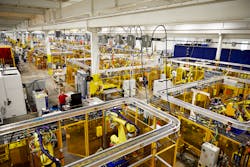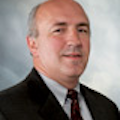Tell us about your company’s state-of-the-art machine-controls technology for manufacturing.
Corey Peruffo, senior product development engineer, JR Automation: JR Automation integrates almost every flavor of the world’s best control technologies. As an integrator, we need to be flexible in integrating to our customer’s needs in order to best support them on keeping their production key performance indicators (KPIs) as high as possible. By being able to conform to any customer’s control platform specification, we can ensure that their maintenance teams are given the best chance to troubleshoot issues quickly and effectively to keep mean time to recovery (MTTR) as low as possible (Figure 1). One of the keys to this, however, is unifying the production data from all of a plant’s systems and bringing that data into a single location of truth to generate actionable insights. That is where JR’s Ingenova360 software suite comes in. Ingenova360 allows for more effective integration of real-time data into business processes by unifying information across an entire facility.
What have been the biggest improvements to machine-controls technology in the past five years?
Corey Peruffo, senior product development engineer, JR Automation: PC-based machine control has really started to soar. Its ability to deliver microsecond scan times with integrated safety and advanced motion controls has really changed the game in all types of automation. Its price point for its performance is also already lower than its PLC competition and offers some creative opportunities by running well-known off-the-shelf (OTS) operating systems onboard. The advent of true “wireless safety” protocols is going to have monumental impacts on the industry as a whole as it allows integrators like JR to offer much more robust and cost-effective safety solutions on larger-scale programs than ever was possible before.
Also read: Hardware preference is immaterial in an open-source world
How has machine-controls technology benefitted from remote monitoring and connectivity?
Corey Peruffo, senior product development engineer, JR Automation: Every machine will, at some point in its life, experience an erroneous failure. These failures may be difficult for on-site personnel to troubleshoot alone, depending on their nature (Figure 2). Remote connectivity has allowed companies like JR to excel in providing aftermarket support to our end customers by allowing us to troubleshoot these failures within minutes of the customer’s calling into our centers, rather than the hours it used to take to send technicians on-site to troubleshoot, diagnose and repair these failures. As the technology evolves, and Industry 4.0 technologies are more widely implemented, we may get to a point where, through advanced monitoring and alerting, original equipment manufacturers (OEMs) are calling customers about possible machine degradation before the customer even knows about it.
Can you explain how software development has changed machine controls in manufacturing?
Corey Peruffo, senior product development engineer, JR Automation: The better tools you can give a skilled individual, the better their work-product can be. With the evolution of better PLC and PC integrated development environments (IDEs), the software that controls engineers are capable of creating has improved drastically. This trend will continue even faster as PC-based control systems start to become more prevalent in the industrial sector. Even above the machine-control level, we have seen huge advancements in supervisory control and data acquisition (SCADA) and manufacturing execution systems (MES) allow more customers to experience successful automation implementations into their upper-level business schemas (Figure 3).
How do control technologies figure into digital-twin platform models being used by manufacturers?
Corey Peruffo, senior product development engineer, JR Automation: We are on the verge of digital twinning being a true reality for both end users and OEMs. As processing power becomes more available via cloud-computing platforms, larger digital twin models are able to be simulated before and after a project implementation. As this technology advances, it is a possibility that OEMs will provide digital-twin models for our customers to use as process-optimization tools throughout the lifespan of the machinery. This also allows for testing of controls code changes prior to online modifications, further reducing risk to production.
Also read: Equipment, production and machines at your service
When will machine controls become IT-friendly enough that engineers are no longer required for installation and operation?
Corey Peruffo, senior product development engineer, JR Automation: We are already there today. Well-programmed repeat machines are fully capable of running self-diagnostics and identifying their own errors. When programmed in this way, it’s totally possible to ship complex machinery to end users directly with installation instructions and allow them to execute this work themselves. Should issues arise that fall beyond the scope of on-site experience, we can employ remote tools in order to help identify and troubleshoot these issues from afar, allowing for the highest possible uptime for our customers.
What future innovations will impact the use of machine-controls technology in manufacturing operations?
Corey Peruffo, senior product development engineer, JR Automation: The next generation of plant-asset tracking and optimization will allow us to identify human resources in a work zone and allow automation to freely flow and optimize itself around human operators and maintenance operations. I foresee a future in which planning tools based on artificial intelligence (AI) are taking real-time inputs from both human operators and machine processes and then self-optimizing an entire facility’s process flow based on those inputs. JR already does half of this equation by monitoring machinery and using AI to optimize autonomous production, but the future is adding in the human element to those optimization algorithms.
Also read: PLCs, PACs, PC-based control—what's the difference?
About the Author
Mike Bacidore
Editor in Chief
Mike Bacidore is chief editor of Control Design and has been an integral part of the Endeavor Business Media editorial team since 2007. Previously, he was editorial director at Hughes Communications and a portfolio manager of the human resources and labor law areas at Wolters Kluwer. Bacidore holds a BA from the University of Illinois and an MBA from Lake Forest Graduate School of Management. He is an award-winning columnist, earning multiple regional and national awards from the American Society of Business Publication Editors. He may be reached at [email protected]

Leaders relevant to this article:





